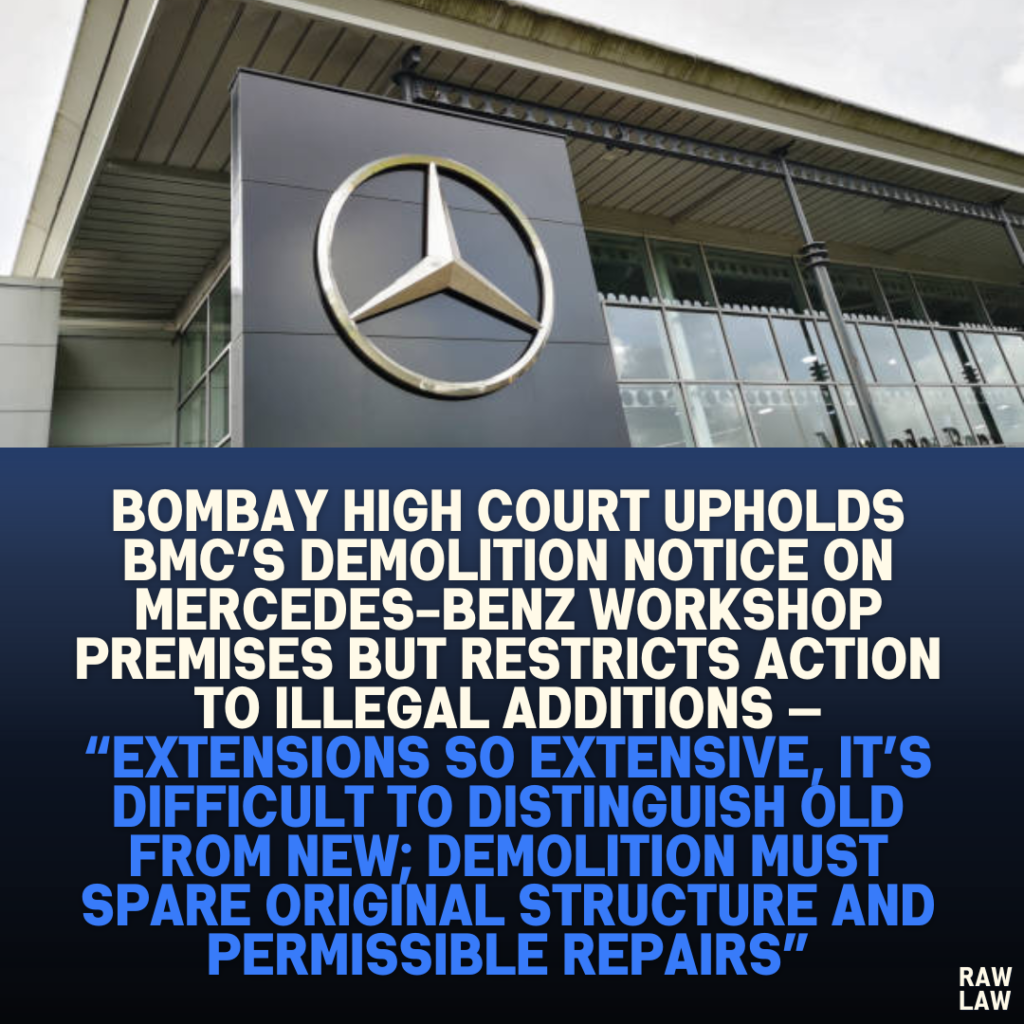Court’s Decision:
The Bombay High Court dismissed the writ petition challenging the BMC’s notice and demolition order under Section 351(1A) of the BMC Act. The Court upheld the BMC’s action to demolish unauthorized structures but directed that the demolition must only affect illegal additions and not the original structure or any permissible repairs. It further granted a stay on the implementation of the judgment until May 26, 2025, to allow the petitioners to approach the Supreme Court.
“An unauthorized structure/s cannot be tolerated and is liable to be demolished… the BMC is directed to ensure that only unauthorized construction/s or extension/s are removed, while legitimate/permissible repairs are left undisturbed.”
Facts:
The petitioners operated a Mercedes-Benz auto workshop from premises claimed to be a tolerated structure predating the datum line of April 1, 1962. They relied on Tikka Sheets from 1935, 1952, and 1969 and BMC’s Assessment Records to establish their claim. The BMC, however, issued a notice under Section 351(1A) of the BMC Act and passed a demolition order alleging unauthorized additions such as a mezzanine floor.
Despite the petitioners’ submission of replies and requests for a hearing along with supporting documents, including a factory license valid until December 31, 2027, the BMC proceeded to issue a demolition order.
Issues:
- Whether the impugned BMC notice and demolition order suffer from procedural and jurisdictional defects.
- Whether the structures fall within the category of tolerated structures predating April 1, 1962.
- Whether the construction carried out qualifies as tenantable repairs or unauthorized additions.
Petitioner’s Arguments:
- The notice was issued without jurisdiction and violated principles of natural justice.
- The structures existed since 1915, as evidenced by historical cadastral documents.
- Additions made were only tenantable repairs required to maintain workshop standards.
- The demolition notice failed to consider vital documents like factory licenses and was motivated by an ulterior motive.
- No opportunity of personal hearing was granted, and the plan relied upon by the BMC was not shared with the petitioners.
Respondent’s Arguments:
- The BMC contended that the petitioners carried out unauthorized alterations including the addition of a mezzanine floor without requisite permissions.
- The demolition order was passed after due procedure and after considering the petitioners’ replies.
- The documents submitted were insufficient to justify the unauthorized constructions.
Analysis of the Law:
The Court emphasized the importance of following due process under the BMC Act and maintaining urban planning norms. It distinguished between tolerated structures and unauthorized extensions, noting that the latter cannot be shielded under the guise of tenantable repairs.
The Court further stressed that:
“The construction of a mezzanine cannot reasonably be classified as a tenantable repair.”
The legal threshold for ‘tolerated structures’ requires both existence prior to the datum line and absence of subsequent illegal modifications.
Precedent Analysis:
Although no specific case laws were cited, the Court reaffirmed its consistent jurisprudence that unauthorized constructions are impermissible regardless of the identity of the occupants, and that courts cannot protect such constructions.
Court’s Reasoning:
The Court found that while some portions of the structure might predate the datum line, the petitioners had clearly made substantial modifications such as a mezzanine without obtaining any permissions.
“Extensions have been made on such a scale that it is difficult, if not impossible, to distinguish between the old and the newly constructed portions.”
The petitioners’ failure to seek approval for these changes, despite their claims of legality, undermined their case. The Court also acknowledged inconsistencies in BMC’s enforcement but held that it could not condone illegality.
Conclusion:
The writ petition was dismissed. However, the BMC was directed to carry out demolition only of the unauthorized portions, sparing the original structure and permissible repairs. A temporary stay on implementation was granted till May 26, 2025.
Implications:
This ruling reaffirms the Court’s intolerance toward unauthorized constructions while simultaneously cautioning the BMC to avoid arbitrariness and selective action. It underscores the need for citizens to seek statutory permissions and for authorities to act consistently and fairly.
“The law must be applied uniformly, and no individual or group can be placed above it.”




Pingback: Delhi High Court Appoints Former Supreme Court Judge as Sole Arbitrator, Rejects Res Judicata Objection: "Respondent’s Objection on Res Judicata Outside Section 11 Jurisdiction, Must Be Addressed by the Tribunal for Proper Adjudication" - Raw
Pingback: Delhi High Court Sets Aside Trial Court Decree Granting Possession Based on GPA Sale Without Proven Possession: “Possession Is the Culmination and Fruit of the Transaction of Sale” - Raw Law